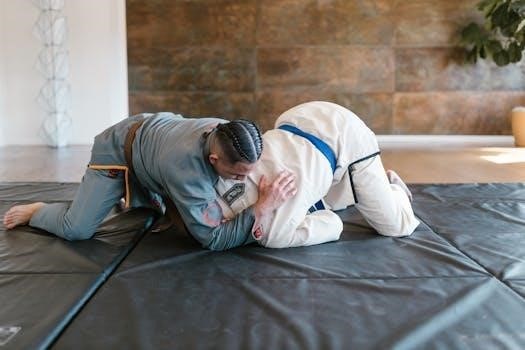Brazilian Jiu-Jitsu (BJJ) is a martial art and combat sport focusing on ground fighting and grappling techniques. It emphasizes leverage and technique over size and strength, making it effective for self-defense and competition. BJJ evolved from Judo and traditional Japanese jujutsu, adapting various grappling techniques.
What is Brazilian Jiu-Jitsu (BJJ)?
Brazilian Jiu-Jitsu (BJJ) is a martial art and combat sport that emphasizes ground fighting and submission holds. It’s a system where a smaller individual can effectively defend themselves against a larger opponent by utilizing techniques like joint locks and chokeholds. BJJ focuses on controlling a resisting opponent, using leverage and technique to gain a dominant position and force a submission. Originating from Judo, it has evolved to include a diverse range of grappling techniques, making it a very complex and effective martial art. It is often described as a chess game of the body. BJJ prioritizes the ability to control and subdue an opponent.
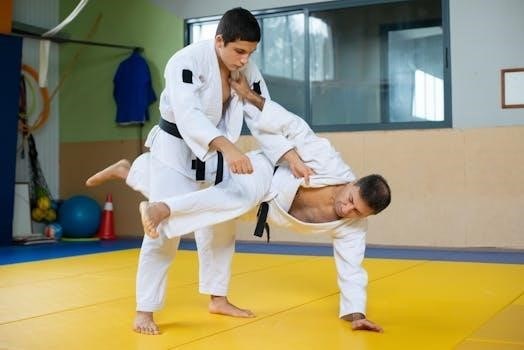
Fundamental Concepts in BJJ
BJJ emphasizes leverage and technique over brute strength, focusing on ground fighting and submissions. It’s crucial to understand body mechanics, angles, and distance to control and overcome opponents.
The Importance of Leverage and Technique
In Brazilian Jiu-Jitsu, leverage and technique are paramount, allowing a smaller, weaker individual to overcome a larger, stronger opponent. Rather than relying on brute force, BJJ emphasizes using body mechanics, angles, and proper positioning to gain an advantage. Understanding how to effectively apply leverage allows practitioners to control and manipulate an opponent’s limbs and body weight. Technique involves the precise execution of movements and transitions, using minimal energy to maximize impact. This focus on leverage and technique is the core principle that makes BJJ such an effective martial art for self-defense and competitive grappling.
Ground Fighting Focus in BJJ
Brazilian Jiu-Jitsu is distinguished by its heavy emphasis on ground fighting and grappling techniques. Unlike other martial arts that focus on striking, BJJ centers around controlling an opponent on the ground, utilizing positions and submissions to gain dominance. The goal is to take the fight to the mat, where leverage and technique become more effective than size and strength. This ground-focused approach allows a practitioner to neutralize an opponent’s striking abilities and utilize joint locks, chokes, and pins to secure a submission. Mastering ground fighting is the cornerstone of BJJ, making it a unique and highly practical martial art.
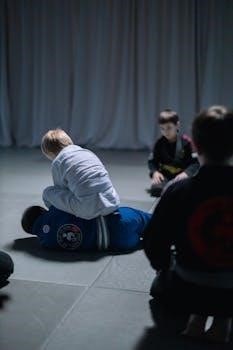
Essential BJJ Positions for Beginners
Understanding key positions is crucial for beginners in BJJ. These positions, like closed guard, mount, and side control, form the foundation for controlling and submitting opponents. Each offers unique advantages.
Closed Guard
The closed guard is a fundamental position in Brazilian Jiu-Jitsu where the practitioner on the bottom wraps their legs around the opponent’s waist, effectively closing them in. This position provides a good level of control and allows for attacks such as sweeps and submissions. It is a very defensive position, and it is often the first position that new practitioners will be taught because of the control it offers. The closed guard allows you to protect yourself and then to think about how to create space or use grips to your advantage. Learning the closed guard is fundamental for all BJJ practitioners.
Mount
The mount is a dominant position in Brazilian Jiu-Jitsu where one practitioner sits on top of their opponent’s torso, controlling them with their legs and hips. This position offers a significant advantage for the person on top, allowing for powerful strikes (in MMA), submissions, and positional advances. Maintaining a stable mount while preventing escapes is a crucial skill. It’s considered a very offensive position that allows for control and the opportunity to secure a variety of submissions. A good mount requires balance and the ability to adjust to the opponent’s movements. Mastering the mount is essential for both offensive and defensive BJJ strategies.
Side Control
Side control is a fundamental and versatile position in Brazilian Jiu-Jitsu where one practitioner is positioned perpendicular to their opponent, controlling their hips and shoulders. This position offers excellent control and the opportunity to transition into more dominant positions or secure submissions. Effective side control involves maintaining pressure, preventing escapes, and utilizing proper body alignment. It is a stable and powerful position from which to execute attacks. The person on top aims to keep their weight distributed and their base solid, while the bottom person attempts to escape and regain guard. Mastering side control is essential for controlling the fight and advancing positions.
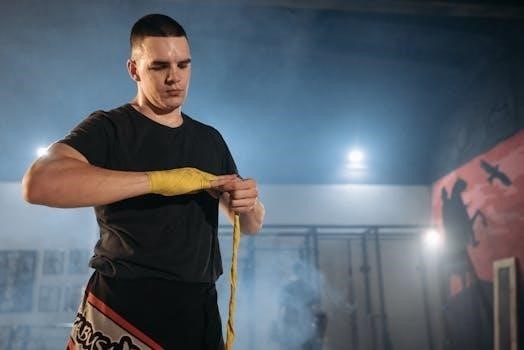
Basic BJJ Movements & Techniques
Fundamental BJJ movements are essential for building a strong foundation. These include warm-up drills, sweeps like the scissor sweep, and techniques such as the technical stand up, vital for positional transitions and overall mat control.
Warm-up Techniques
Starting with proper warm-up techniques is crucial in BJJ, preparing the body for the demands of training. These exercises often include dynamic stretches, such as arm circles, leg swings, and torso twists, increasing blood flow and joint mobility. Movements like shrimping, bridging, and bear crawls help to develop coordination and muscle activation, specifically focusing on muscles used during grappling. Light calisthenics, such as push-ups and squats, can be incorporated; These warm-ups are designed not only to prevent injuries but also to improve body awareness and movement efficiency which is essential for all the BJJ techniques to be executed effectively. Effective warming-up is key to a good training session.
Scissor Sweep
The scissor sweep is a fundamental technique in Brazilian Jiu-Jitsu, crucial for transitioning from guard to a dominant top position. Executed from the closed guard, it involves using your legs to create a sweeping motion, unbalancing your opponent. One leg hooks behind the opponent’s knee while the other pushes against their hip, using a scissor-like action to generate momentum. Simultaneously, you use your arms to control their posture and pull them off balance. Proper timing and hip movement are essential for a successful scissor sweep, enabling you to gain a superior position and execute further attacks. Mastering this sweep is vital for any BJJ practitioner.
Technical Stand Up
The technical stand up is a fundamental BJJ movement used to safely and efficiently transition from a grounded position back to a standing posture. It’s a vital skill for escaping potentially dangerous situations on the mat. Starting from a seated position, you post one hand on the ground while simultaneously bringing one leg up, placing your foot flat on the mat. Then, you drive off your hand and foot, bringing your hips up and your other leg back to stand. This coordinated movement maintains a stable base and prevents you from being easily swept or taken down during the transition. Mastering the technical stand up is crucial for controlling the pace of a match and avoiding submission attempts.
Key BJJ Submissions for Beginners
Beginners in BJJ should focus on mastering foundational submissions. These include joint locks and chokes that are effective from common positions. These techniques will build a strong foundation for further learning.
Arm Bar from Guard
The arm bar from guard is a fundamental submission in BJJ, utilizing leverage to hyperextend the opponent’s elbow. Start by controlling your opponent’s posture from the guard, securing one arm with your legs and the other with your hands. Next, swing your leg over the opponent’s head, positioning your hips to create the necessary angle for the arm bar. Maintain control of the wrist and elbow throughout the movement, using your body to apply pressure and force the submission. Proper technique and body mechanics are crucial for a successful arm bar, emphasizing control and leverage rather than brute strength. Remember to practice this with a partner, ensuring safety first.
Guillotine Choke
The guillotine choke is a powerful submission in BJJ, targeting the opponent’s neck and restricting blood flow to the brain. It’s typically applied from a front headlock position, wrapping one arm around the opponent’s neck and securing the grip. The key is to maintain a tight hold and use your body to apply pressure, forcing a submission. Various grips and positions can be used for the guillotine, with nuances affecting its effectiveness. Practicing this technique safely and correctly is vital, emphasizing proper positioning and pressure application. This submission requires sensitivity and control, always prioritizing your training partner’s safety. It’s an essential technique for any BJJ practitioner to learn.
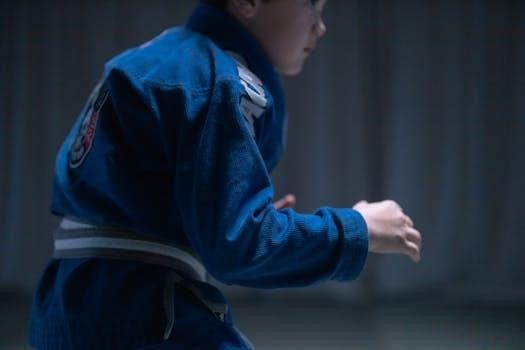
BJJ Principles and Strategies
BJJ emphasizes leverage, technique, and strategy over brute strength. Key principles include body awareness, relaxation, and the importance of tapping early. Understanding these concepts is crucial for effective training and safety.
The Importance of Tapping
In Brazilian Jiu-Jitsu, tapping is not a sign of weakness but a crucial learning tool and a way to prevent injury. Tapping early and often allows practitioners to train safely and explore different positions and techniques without fear of overextending or risking joint damage. It is a fundamental aspect of BJJ etiquette and training culture, demonstrating respect for your training partner and yourself. Tapping signals submission, allowing the training session to continue without unnecessary risk. By tapping, you acknowledge your position and allow you to learn and improve. This allows you to train harder for longer and prevents injury.
Relaxation and Body Awareness
Relaxation and body awareness are fundamental principles in Brazilian Jiu-Jitsu. Tension wastes energy and hinders technique, whereas a relaxed body moves more efficiently and fluidly. Developing body awareness allows you to understand your position and your opponent’s movements, enabling you to react effectively. By being mindful of your body, you can identify openings, create space, and avoid being caught in vulnerable positions. Cultivating relaxation improves your ability to conserve energy, manage your breathing, and execute techniques with precision. It also helps to reduce the risk of injury by avoiding unnecessary muscle strain. This is a key principle that must be learned for success in BJJ.
Mastering basic BJJ techniques is crucial for a strong foundation. Consistency, practice, and patience are key to success. This will help you progress and enjoy your BJJ journey.
Building a Solid Foundation in BJJ
Establishing a strong base in Brazilian Jiu-Jitsu requires dedicated focus on fundamental techniques and movements. Beginners should prioritize mastering core positions like guard, mount, and side control, understanding their principles and transitions. It’s essential to drill basic sweeps, submissions, and escapes, ensuring proficiency before attempting advanced maneuvers. Consistent practice, patience, and a willingness to learn are paramount. Focus on developing a solid understanding of leverage and body mechanics, rather than relying on strength. Remember to tap early and often, using it as a valuable learning tool. Building a solid foundation will allow for better progress. Prioritize drilling techniques to develop muscle memory.
